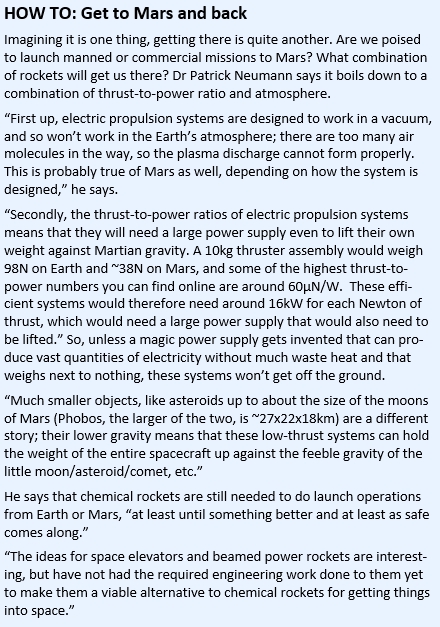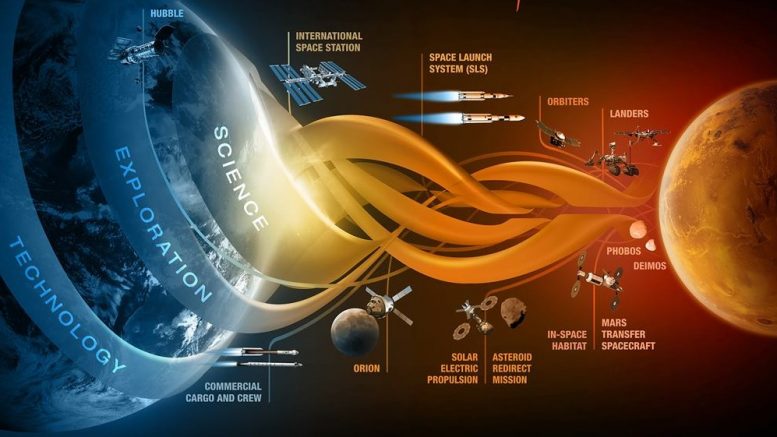EXCLUSIVE Interplanetary travel: science has finally caught up with fiction, James Fitzgerald discovers.
Gene “Star Trek” Roddenberry’s vision of a pioneering intergalactic society has been with us since the 1960s, but only now is the terminology of warp drives and terraforming becoming science fact.
United States President Donald Trump used the 45th anniversary of the Apollo 17 lunar landing last week to sign a policy directive telling Nasa to focus efforts on human exploration, with one eye on the Moon and the other on Mars.
Elon Musk of SpaceX has waxed lyrical on reaching Mars and commercialising his rocket operations, but his targets have seemed to defy logic. Until now, that is.
Patrick Neumann, the founder and chief scientist at Neumann Space, has taken a giant leap beyond wasteful and inefficient chemical rockets with his ion propulsion engine. His system has just broken the world record for specific impulse previously held by Nasa’s HIPEP (High Power Electric Propulsion) thruster.
Current flight-rated systems fall into two main types: chemical and electrical propulsion. “Chemical rockets are how we get into orbit today and they are currently the best technology for the job. They are solid and dependable, but not really efficient at producing thrust,” Dr Neumann told Chief-Exec,com. “Electrical systems, such as the Hall effect and ion thrusters, are much more efficient than chemical systems, but require rare elements such as xenon for fuel and produce low thrust. What exists today is good for what we’ve done in the past in space, but if we want to do anything more taxing, then we’ll need still more efficiency, which is where our thruster comes in.”
While at the University of Sydney, Dr Neumann volunteered for a project measuring the parameters of a “pulsed cathodic arc plasma discharge”. “Using these results and a bit of statistics, I figured out that the average titanium ion velocity was about 23km/s, which compares favourably with certain flight-rated systems. I figured that you could make a rocket out of it, and so have been working on this for some years now,” he says.
Neumann Space’s solar-electric ion drive uses a pulsed cathodic arc technology, paired with a solid fuel rod. It is in fact a plasma thruster in that the exhaust is a “quasi-neutral plasma” which has electrons mixed in with the ions. This means that there is no need to inject electrons into the exhaust to neutralise the exhaust to prevent spacecraft charging.
The “Neumann Drive” can run on a variety of solid metallic fuels, with the makeup affecting the level of thrust and impulse generated. This means that it can utilise nearly any metal likely to be found in asteroids, as well as on “sintered-down” space junk.

“Our technology allows a number of missions that have been proposed but not committed to due to the right propulsion system not being available,” says Dr Neumann. Space tugs equipped with the ion drive could be able to transfer cargo, such as satellites and station modules, to more distant destination orbits. It would allow surveying and prospecting missions to numerous near-Earth objects, including cargo delivery to Mars’ orbit in preparation for human missions.
The drive would also allow satellites to hold stationary positions in intermediate space – beyond the Earth’s orbit. Sunna-Wedra, the German start-up behind a solar early warning constellation, has adopted the Neumann Drive to underpin its satellite mobility. “The innovative Neumann Drive enables us to keep the satellites in their positions for an economically attractive period of time,” says Lars Bolduan, the project manager for Sunna-Wedra.
Dr Neumann thinks Elon Musk’s plans for reaching and colonising Mars are achievable. “I can see nothing wrong with the physics of his plans, but the engineering and the economics are going to be very challenging.”
However, he is humble about the initial limitations of the technology. “First off, our tech is immature at this point in time, and lacks flight heritage; it’s never been to space. Secondly, while we have better specific impulse than anything flight rated, we do not match those systems in power efficiency, specifically in terms of thrust-to-power ratio. This feeds into a third point, power budget; simply put, our system needs power at lower voltage, but higher current, than other systems, which will require some redesigning of satellite power systems.”
As with most new paradigms, new solutions create new problems of their own.
The Australian start-up has signed an agreement with Airbus Defence and Space for a hosted payload aboard the new Bartolomeo platform of the International Space Station.
“Our ‘ISS balcony’ provides a highly cost- and time-efficient means to perform a space mission in LEO [low Earth orbit] or to test and validate new technology in orbit,” says Bart Reijnen, head of On-Orbit Services and Exploration at Airbus Defence and Space.
Neumann Space’s Facility for the Australian Space Testing programme (Fast) will send a collection of payloads starting at just 1kg mass, together with the Neumann Drive, to be operated in space for up to 12 months. The ISS payload launch is scheduled for late 2019.





